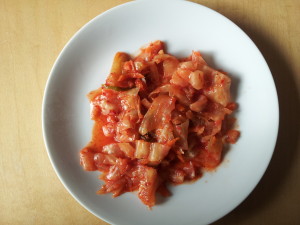 As you may have noticed, I write about the beneficial bacteria Lactobacillus sakei a lot. This is because it has turned out to be a great treatment for both chronic and acute sinusitis for my family and others (see post The One Probiotic That Treats Sinusitis). We originally found it in kimchi (it occurs in the kimchi during normal fermentation), but not all kimchi brands. Kimchi is a mix of vegetables (including typically cabbage) and seasonings, which is then fermented for days or weeks before it is eaten.
As you may have noticed, I write about the beneficial bacteria Lactobacillus sakei a lot. This is because it has turned out to be a great treatment for both chronic and acute sinusitis for my family and others (see post The One Probiotic That Treats Sinusitis). We originally found it in kimchi (it occurs in the kimchi during normal fermentation), but not all kimchi brands. Kimchi is a mix of vegetables (including typically cabbage) and seasonings, which is then fermented for days or weeks before it is eaten.
Why is L. sakei found in some kimchi, but not all? Which vegetable or spice is needed or important for encouraging L. sakei growth? It turns out it is not the cabbage - which is why L. sakei is not normally found in sauerkraut.
A recent study looking at several kimchi samples found that garlic seems to be important for the development of various Lactobacillus bacteria, of which L. sakei is one. The results mean that raw garlic has very low levels of L. sakei, and it multiplies during kimchi fermentation. Note that as fermentation progresses, the bacterial species composition in the kimchi changes (this is called ecological succession).
Korean studies (here and here) have consistently found L. sakei in many brands of kimchi (especially from about day 14 to about 2 or 2 1/2 months of fermentation), but not all kimchi brands or recipes. L.sakei, of which there are many strains, is so beneficial because it "outcompetes other spoilage- or disease-causing microorganisms" and so prevents them from growing (see post).
Excerpts are from the blog site Microbial Menagerie: MICROBES AT WORK IN YOUR KIMCHI
Cabbage is chopped up into large pieces and soaked in salt water allowing the water to draw out from the cabbage. Other seasonings such as spices, herbs and aromatics are prepared. Ginger, onion, garlic, and chili pepper are commonly used. The seasonings and cabbage are mixed together. Now the kimchi is ready to ferment. The mixture is packed down in a glass container and covered with the brining liquid if needed. The kimchi sits at room temperature for 1-2 days for fermentation to take place....Kimchi does not use a starter culture, but is still able to ferment. Then where do the fermentation microbes come from?
Phylogenetic analysis based on 16S rRNA sequencing indicates that the kimchi microbiome is dominated by lactic acid bacteria (LAB) of the genus Leuconostoc, Lactobacillus, and Weissella. Kimchi relies on the native microbes of the ingredients. That is, the microbes naturally found on the ingredients. Because of this, there may be wide variations in the taste and texture of the final kimchi product depending on the source of the ingredients. In fact, a research group from Chung-Ang University acquired the same ingredients from different markets and sampled the bacterial communities within each of the ingredients. The group found a wide variability in the same ingredient when it was bought from different markets. Surprisingly, the cabbage was not the primary source of LAB. Instead, Lactic acid bacteria was found in high abundance in the garlic samples.
Note that Lactobacillus sakei is an example of a lactic acid bacteria. More study details from the Journal of Food Science: Source Tracking and Succession of Kimchi Lactic Acid Bacteria during Fermentation.
This study aimed at evaluating raw materials as potential lactic acid bacteria (LAB) sources for kimchi fermentation and investigating LAB successions during fermentation. The bacterial abundances and communities of five different sets of raw materials were investigated using plate-counting and pyrosequencing. LAB were found to be highly abundant in all garlic samples, suggesting that garlic may be a major LAB source for kimchi fermentation. LAB were observed in three and two out of five ginger and leek samples, respectively, indicating that they can also be potential important LAB sources. LAB were identified in only one cabbage sample with low abundance, suggesting that cabbage may not be an important LAB source.
Bacterial successions during fermentation in the five kimchi samples were investigated by community analysis using pyrosequencing. LAB communities in initial kimchi were similar to the combined LAB communities of individual raw materials, suggesting that kimchi LAB were derived from their raw materials. LAB community analyses showed that species in the genera Leuconostoc, Lactobacillus, and Weissella were key players in kimchi fermentation, but their successions during fermentation varied with the species, indicating that members of the key genera may have different acid tolerance or growth competitiveness depending on their respective species.
Although W. koreensis, Leu. mesenteroides, and Lb. sakei were not detected in the raw materials of kimchi samples D and E (indicating their very low abundances in raw materials), they were found to be predominant during the late fermentation period. Several previous studies have also reported that W. koreensis, Leu. mesenteroides, and L. sakei are the predominant kimchi LAB during fermentation (Jeong and others 2013a, 2013b; Jung and others 2011, 2012, 2013a, 2014).
